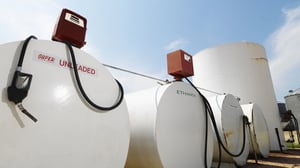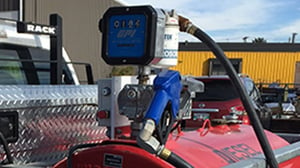Regarding fuel, remote working operations such as construction sites, open pit mines, commercial farming and logging operations create unique challenges for the fleet or operations manager.
Table of Contents
Introduction
Risks Associated with Above-Ground Storage Tanks (ASTs)
The Risks Associated with Fuel Transfer Tanks
Tracking the Fuel Consumption and Costs of ASTs and Transfer Tanks
Solutions for Fuel Management of ASTs and Transfer Tanks
Great! All This Information - Now What?
Is this Fuel Management Technology Practical for my Small Fleet?
It is well known that the two significant costs of operating any fleet are fuel and maintenance. Fleet managers understand that handling these costs is mandatory so they do not escalate out of control. It is also well known that you can not save what you can not measure. Regarding fuel, remote working operations such as construction sites, open pit mines, commercial farming and logging operations create unique challenges for the fleet or operations manager. 
Depending on the size of the project or operation, one or several above-ground storage tanks (ASTs) may be strategically placed so that fueling up vehicles and equipment can be efficient. Additional mobility may require trucks equipped with transfer tanks to transport fuel to equipment in hard-to-reach locations. The decision to implement the storage of gasoline, diesel or other types of fuel lubricants opens up many risks and benefits. Remote bulk fuel storage opens up the risks for possible surface and groundwater contamination, soil contamination, vandalism of the storage equipment and theft. One needs to consider if zoning regulations come into play, the reduction of cash flow for bulk fuel purchases, added insurance premiums and state/provincial regulatory controls.
The benefits of remote bulk fuel storage are the convenience to the operations to fuel up as required without much production downtime and the lower bulk fuel prices a company can enjoy. This alone can offset the risks and is commonly accepted as the best for the project and operations. Watch Video Here
The Risks Associated with Above Ground Storage (AST) of Fuel
In the US, facilities and construction sites with above-ground storage tanks holding fuel of any kind may be subject to U.S. EPA's Spill Prevention, Control, and Countermeasure (SPCC) regulation (40 CFR Part 112). While this article will concentrate predominantly on the accounting and measurement of fuel consumption from the point of view of a fleet manager, the risks of ASTs will be briefly listed. They are as follows:
Water and Soil Contamination
With any fuel storage facility, regardless of its size, there exists a possibility of contamination of the soil and surface water or groundwater. A secondary spill containment system or spill berm is often required by state/provincial and federal environmental authorities. The containment system should be large enough to contain all the liquid from the largest tank (if multiple tanks are grouped together). Check to make sure your AST installation complies with local regulations.
contamination of the soil and surface water or groundwater. A secondary spill containment system or spill berm is often required by state/provincial and federal environmental authorities. The containment system should be large enough to contain all the liquid from the largest tank (if multiple tanks are grouped together). Check to make sure your AST installation complies with local regulations.
Decreased Property Value Due to Spills and Releases
Fuel and oil spills are unsightly and environmentally hazardous. The property becomes devalued due to the possible clean-up operations and costs associated with bringing the property into compliance. This can also prevent the sale or transfer of the property down the road. If a spill goes unreported, an environmental audit could cause issues when it comes time to sell or transfer the property.
Cleanup Costs
If a spill occurs, the cleanup costs will be high since qualified contractors need to be deployed to conduct the cleanup and environmental testing needs to be completed to establish the area has been effectively decontaminated.
Evacuation of Nearby Neighborhoods in the Event of a Sizable Release
Depending on the location of the construction project, a large spill of hydrocarbons can require the evacuation of the surrounding area. Is there an evacuation procedure in place for such an event?
Theft and Vandalism
Remote fuel storage facilities invite theft and vandalism. What have you implemented to mitigate the chances of vandalism and fuel theft from trespasses? ASTs should have yellow or red safety bollards placed around the tanks to prevent vandals from using a vehicle to damage the tank. Bollards also prevent fleet vehicles from accidentally hitting the tanks. For theft, some ingenious technologies are available to ensure only pre-approved vehicles can obtain fuel. This will be discussed later in the article.
Insurance Specifications
Consult your insurance provider for their opinions and requirements to keep your premiums as low as possible and what coverage you may have in case of environmental cleanup. Additionally, ASTs will require frequent inspections, and documentation will be required for proof of inspection. In addition, three main types of AST failures can result from storms and hurricanes/tornadoes, and they are:
- Wind-induced tank wall buckling
- tank buckling induced by water surges or flooding
- dislocation of the tank from the ground base due to water surges, flooding or excessive wind.
The Risks Associated With Fuel Transfer Tanks
Fuel transfer tanks that deliver fuel to equipment working in remote areas  of the site bring their own set of risks. First, the transfer tanks must be manufactured and approved by the appropriate authority or agency. The nozzle and hose must also be approved for fuel transfer and kept in good condition. Weather and ambient conditions on a construction site and seldom ideal. The chances of small spills are high. Proper spill response equipment must always be nearby to address any occurrence of spills. Training on equipment handling, spill response and reporting is required.
of the site bring their own set of risks. First, the transfer tanks must be manufactured and approved by the appropriate authority or agency. The nozzle and hose must also be approved for fuel transfer and kept in good condition. Weather and ambient conditions on a construction site and seldom ideal. The chances of small spills are high. Proper spill response equipment must always be nearby to address any occurrence of spills. Training on equipment handling, spill response and reporting is required.
Tracking the Fuel Consumption and Costs of ASTs and Transfer Tanks
When one or more remote AST fuel storage facilities operate, this can create logistical nightmares for the fleet or operations manager. How much fuel is being delivered and when? How accurate is the volume delivered? Generally, no one may be around when your fuel tank is filled. When do you schedule your next fuel delivery? Running out of fuel causes the project or production to come to a grinding halt. This downtime is extremely costly to the organization as the crew and equipment remain idle.
The frequency, time of day and how much fuel is dispensed to trucks with transfer tanks must be tracked and documented. Which equipment is filled from the mobile transfer tanks, with how much fuel and at what time of the day? As you can see, there seem to be more questions than answers and complex data. This opens the door to escalating fuel expenses for your operations or construction project.
When you have several employees involved with the fueling operations to  keep your project or production moving forward, having your team provide you with timely information for your reconciliation reports can be similar to herding sheep. You must continuously chase to get the needed numbers to manage your fuel expenses. The tedious procedure of record keeping is demanding enough in an office environment. However, when records need to be kept in the field with inclement weather, harsh ambient temperatures and addressing other production emergencies, the chances of irregularities, incorrect documentation or infrequent documentation increase.
keep your project or production moving forward, having your team provide you with timely information for your reconciliation reports can be similar to herding sheep. You must continuously chase to get the needed numbers to manage your fuel expenses. The tedious procedure of record keeping is demanding enough in an office environment. However, when records need to be kept in the field with inclement weather, harsh ambient temperatures and addressing other production emergencies, the chances of irregularities, incorrect documentation or infrequent documentation increase.
Solutions for Fuel Management of ASTs and Transfer Tanks
Let us face the facts. As a fleet manager who needs to track and control fuel consumption as part of your operating costs, you will need help. We will look at some technology that can alleviate your struggle and give you more time to invest in more proactive and productive activities.
Above Ground Storage tank Fuel Inventory
Would it not be great to know exactly how much fuel is in your storage tanks? Electronic tank probes can go a long way to help. When you order fuel from your petroleum provider, you can know precisely how much fuel was delivered and when? The suitable probes on your ASTs will ensure you can monitor your fuel inventories in real-time from your desk. Be alerted to dangerously low inventory. Order fuel exactly when needed and keep  your production or site operations running with reduced downtime. For remote fueling facilities, these probes can alert you to possible leaks if no activity is recorded but the levels drop. Early leak detection can save you thousands in environmental cleanup costs, fines and possible increased insurance premiums.
your production or site operations running with reduced downtime. For remote fueling facilities, these probes can alert you to possible leaks if no activity is recorded but the levels drop. Early leak detection can save you thousands in environmental cleanup costs, fines and possible increased insurance premiums.
Fuel Distribution Management
Now that your remote fuel tanks have been topped off, how can you regulate what vehicles and equipment get fuel from that location? How can you control the remote site so only authorized can access the fuel? An RF Authorizer on your vehicles and equipment can ensure your desired security. You can even avert the risks of dispensing the wrong product when multi-hose configurations are utilized.
Mobile Transfer Tank Fueling Management
When sending your equipment to the nearest AST is not practical, light-duty trucks with regulation-approved transfer tanks can transport the fuel to the equipment. This often includes dispensing in rough terrain, inclement weather and harsh temperatures. Keeping good records is essential but often tricky at the best of times, not to mention the added time involved. With a convenient mobile app, access to fuel is streamlined, so fuel runs are shortened, thus increasing your team's efficiency in the field. When your equipment is equipped with an RF Authorizer, you can rest peacefully so that only your operations are being fueled up.
Great! All This Information - Now What?
Having the correct information available to manage fleet fuel consumption and costs from your remote operations can be a blessing or a curse. Information can be a blessing because you can now save what you can measure. You can access who is doing what, at what time of the day, how much and how often ... all from the comfort of your office.
Information can also be a curse if it overloads you with unmanageable data and numbers and prevents you from making sense of the data, making intelligent decisions and producing timely reports to upper management. A proper fuel management solution will make fuel reconciliation reports easy.
A cloud-based integrated fuel management software can do all the heavy lifting for you. Imagine being in control and knowing exactly what is happening in the field from your office, or anywhere you can access the cloud. The software should allow you to manage how you want to see your data and how you want your reports displayed. Information is great only if it can be easily managed with a high degree of automation, giving you additional time to concentrate on other proactive priorities.
Is this Fuel Management Technology Practical for my Small Fleet?
Elaborate systems like the one described may seem cost prohibitive for smaller fleet operations. At Coencorp Fleet Management, we understand your unique situation. We have been managing fleet fuel issues for over 30 years. This is why we have addressed the concerns of fleet managers of smaller operations and kept the hardware peripherals to an essential minimum. We offer fleet managers of smaller operations access to big companies' fuel management cloud-based software. All of this is within an investment that suits your budget.
smaller fleet operations. At Coencorp Fleet Management, we understand your unique situation. We have been managing fleet fuel issues for over 30 years. This is why we have addressed the concerns of fleet managers of smaller operations and kept the hardware peripherals to an essential minimum. We offer fleet managers of smaller operations access to big companies' fuel management cloud-based software. All of this is within an investment that suits your budget.
If you anticipate your operations to grow over the years, your system should grow with you. We offer integrated fleet management solutions, so when you need to tackle fleet maintenance, geo-fencing facilities for added security and incorporate telematics/GPS so more vital information is at your fingertips, Coencorp can provide the integrated solutions with your need. We also have a fully staffed support team eager to guide you through the setup and implementation.
Contact us today. Tell us about your remote fleet fueling issues, and we can work with you to provide you with a solution that makes sense.
